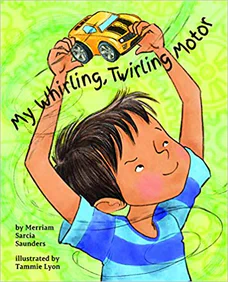My Whirling, Twirling Motor
Written by Merriam Sarcia Saunders
Illustrated by Tammie Lyon
32 pages
•
Published 2019 (Magination Press)

Recommended Age Range: Preschool through 2nd grade.
Publisher's Summary:
Charlie feels like he has a whirling, twirling motor running inside him all the time and sometimes he just can’t settle. When his mom wants to talk to him, he figures he’s in trouble…but she has a surprise for him instead!

Dr. Annie's Takeaways
Recommended for: This book is an excellent read for kids with hyperactivity and/or impulse control challenges (including kids with an ADHD diagnosis) who need a reminder that they’re “wonderful.” It prompts caregivers to remember to point out a child’s strengths and positive behaviors, which is both necessary for kids’ self-esteem and a very effective strategy for supporting positive behavior change.
Evidence-Based Practices:
Specific Praise
Tone: Earnest, emotionally evocative, sweet
Story Quality: This story portrays really well the experience many kids with ADHD have of their behavior feeling frustratingly out of their own control. Charlie describes all the ways that his internal “motor” makes him do things that he regrets. The ending is super sweet (spoiler: his parents point out all of the “wonderful” things he did that day), and will likely come as a surprise to children reading this story who are all too used to adults pointing out the mistakes they’ve made. It’s ultimately a very positive book, which is much needed in the ADHD literature.
Illustrations: Colorful, attractive illustrations with heart
Representation: Charlie is a boy with light brown skin and brown hair. He has a mother and a father. No diagnoses are used in the story, but many children with ADHD-Hyperactive Type will relate to Charlie’s experiences. He gets distracted from his chores, has trouble sitting still during story time, talks out of turn in class, touches things he’s not supposed to, and throws a ball at a classmate when he is excluded for making noises that his peers found “annoying.”
Psychological Practices: Charlie will likely be relatable to a lot of kids with hyperactivity and/or ADHD, and many kids will feel reassured by the language he uses to explain his behavior challenges (i.e., the motor is making him do it; it’s not that he’s not a bad kid). This book reminds parents and caregivers that young kids with ADHD often truly feel that their behavior is out of their control, and it’s not a comfortable feeling for them! The book ends with Charlie’s mom sharing a “Wonderful List” of specific things that she appreciated about him that day (e.g., “took your cereal bowl to the sink without being asked”), and this helps him to relax and go to sleep (“My buzzing, twirling, humming motor settles to a quiet purr.”). It’s an excellent intervention for two reasons: 1) Kids with ADHD are unfortunately often bombarded by criticisms all day long and are much more at risk of developing low self-esteem, so pointing out their strengths is necessary as a counterpoint. 2) Pointing out and praising behaviors that we want a child to engage more in is an evidence-based strategy for improving behavior. In fact, it’s way more likely to result in behavior change if an adult praises a child for engaging in a behavior we want them to be practicing (e.g., staying on task while brushing their teeth) than if they criticize the child for not doing what is asked of them (e.g., for getting distracted).
Concerns: None
